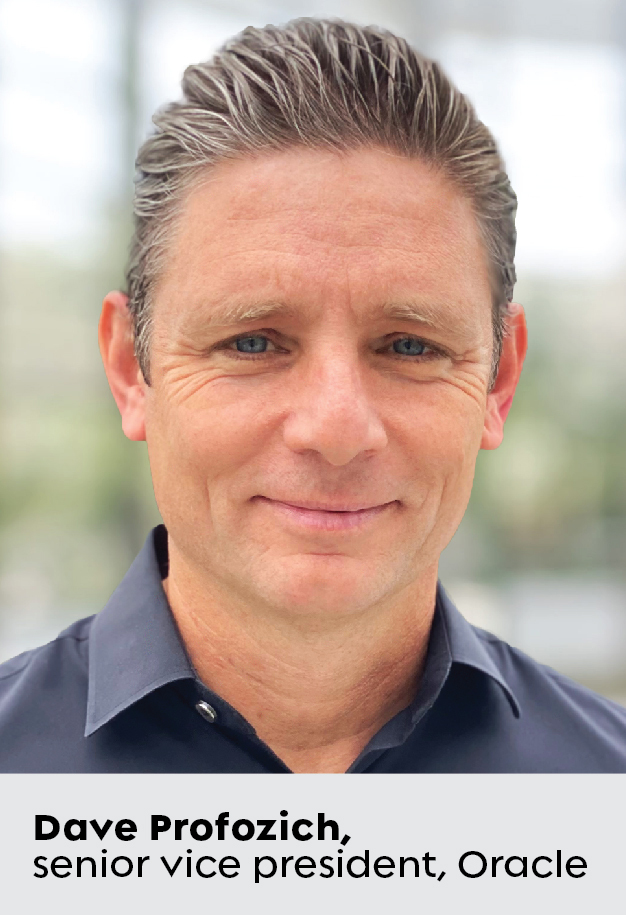How Oracle Sees the Future of Enterprise Cloud Computing
The pandemic fast-tracked cloud migration, enabling remote work and underpinning global supply chains. Oracle’s Dave Profozich shows us the way forward.
For enterprise leaders, the pandemic accelerated digital change on a massive scale.

Forced to socially distance, millions embraced telehealth for the first time. Organizations of every size transformed their workforce, employing videoconferencing, document sharing, and augmenting workers with automation and artificial intelligence. Seamless digital experiences, from e-commerce to government services, began to be the norm rather than an anomaly.
But no area reflected this sea change like the adoption of cloud services. For years, business leaders and IT directors claimed in surveys that they planned to migrate off expensive on-premises servers and onto the cloud’s more flexible platform. But because of concerns about migration and security, and just plain organizational inertia, they didn’t do it.
Tanium’s Cyber Hygiene Assessment: An actionable path to better endpoint management and security
Fast-forward to 2020, when some two-thirds of IT decision-makers surveyed by PSB Insights say they’ve accelerated plans to move parts of their business into the cloud, compared with their pre-pandemic timelines. As remote work continues to define the future, as workers require access to remote applications and organizations need more data storage, as well as endpoint management and security over tens of thousands of digital devices, that migration will continue.
But why did it take a crisis for cloud computing to grow, for private and government organizations to realize that a cloud dimension to operations makes financial, strategic, and logistical sense?
Dave Profozich, senior vice president at Oracle’s independent software vendor (ISV) ecosystem, spoke to Endpoint about the previous foot-dragging, how CIOs should approach migration, which functions to migrate first, and the importance of changing IT culture in the process.
Cloud migration would seem to be a no-brainer for many companies. Yet there seems to be some hesitancy and misunderstanding over its adoption. Why is that?
When you look at the leadership of a company, you typically have the CEO, the CFO, the CIO, and the CSO, who all generally share the mission of keeping the company out of harm’s way. And for a long time, those executives did not trust the cloud. With all the regulatory pressure to be secure, even when the business case seemed obvious, inertia in moving to the cloud remained, primarily because of a fear of security risks.
How has this mindset changed?
The tipping point occurred probably in the last two to five years. Most CIOs now say their strategy is cloud first. There seems to be agreement generally that the cloud is safe. You pick up safety and security and you don’t lose control. Really, it’s more risk not to move to the cloud than to move to the cloud.
What about the on-site data storage systems and infrastructure?
That’s the other issue. Say you are the CEO, and you believe the right thing to do is embrace the cloud and stop building data centers and managing computers. But you have these architectures that can be difficult to move. You’ve got a lot of legacy applications that have been custom-made, or kind of bespoke.
Really, it’s more risk not to move to the cloud than to move to the cloud.
They’re probably buggy as heck, and the workforce who built them is probably no longer at the company. With Oracle Cloud, we’ve made it easier for customers to migrate their critical enterprise applications to the cloud, run them more effectively than on-premises, and achieve better performance at a lower cost.
So, what’s your message to the C-suite when they’re considering a move to the cloud?
Do it. Get started today.
When you move from on-premises to Oracle’s cloud, you get better security, better performance, and higher availability at a lower cost. Even if it’s just a lift-and-shift of existing applications from on-premises to Oracle Cloud Infrastructure (OCI), you will see performance benefits and free up staff that previously focused exclusively on keeping the lights on.
[Read also: How the cloud can be efficient and safer for regulated industries]
And if you migrate from on-premises applications to cloud applications, you also get more frequent feature updates, so your employees can always have the latest and greatest tools at their disposal.
I know that a comprehensive, all-at-once migration is impossible for most organizations, so start with the workloads that are easiest to move. Pick off low-hanging fruit. Get those immediate benefits and go from there.
What percentage of company IT workloads do you think are on-premises versus cloud?
I would guess it’s still 20% cloud, 80% on-premises. Maybe it’s 25-75. There’s definitely a large majority still on-premises, especially larger mission-critical applications. I think the trick now is if you’re a savvy CIO and you’ve moved finance, HR, payroll, and procurement, your next move is the big guy, the performance elements of the business.
Companies like Tanium can help with that. They have the technology that enables enterprises to evaluate workloads that are movable to the cloud—not to mention the importance of Tanium’s cloud-based endpoint management and security. They can help the CIO line up that next 20% shift.
And when they get all the parts of the business in the cloud, companies can still make improvements, right?
Our strategy is to help the enterprise fine-tune their applications, retire old applications, innovate, and modernize. This also gives customers flexible options to meet their business needs, whether on-premises, multicloud, or hybrid. Our next-gen OCI is a better experience than Gen 1 clouds, where complex, compute-intensive enterprise workloads were running 40% slower than they were on-premises, or they couldn’t even run.
[Read also: Zemax goes cloud-first with help from Tanium as a Service]
Now, the market is more mature, so it doesn’t have to be one size fits all. Customers can select the best cloud for a specific workload. Multicloud is the new normal, and customers are moving increasingly complex workloads to the cloud as a result.
So, I think with a partner like Tanium, we can help take that executive from 80% on-premises and 20% cloud to maybe 50-50.
When will we see that 50-50 split?
I think it will happen in the next five years. The one thing that will help accelerate the pivot is a lot of the software that’s being run in the on-premises data centers will naturally time out. Everyone in the software industry is innovating in the cloud.
At some point, on-premises systems will be like fax machines or rotary phones. You might see them, but not often.
That’s where the R&D is going, so businesses that want the latest tools will have to migrate to the cloud to get them. At some point, on-premises systems will be like fax machines or rotary phones. You might see them, but not often.
How do CIOs describe their conversations with the board when they consider a move to the cloud? Especially when you can have so many people reliant on a legacy software system.
It’s not easy. There’s a view that 80% of CIOs run and maintain operations while 20% innovate. But once you’re in the cloud, that ratio shifts to more innovation. So it’s a very strategic victory point once a company makes the pivot. But making the pivot itself is the tough part.
In some ways, there’s a lot to be said for going big in the move to the cloud, given the work that’s involved. How do you make the big transformational argument?
There’s a culture element to it, right? One way to start changing an IT culture in a large enterprise is to have your IT employees certified in a public cloud. The point is that once you have full certification, you start thinking about how to leverage developer tools, how to manage your applications. Among midsize companies, there’s the potential for greater unity and enterprise-wide engagement, and I do think generally you can move faster, but larger enterprises can get there, too.








